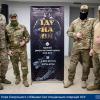Збирач потоків
I put together another free form Nixie Tube Clock
 | So, I tried to free form a similar clock I free formed earlier this year, except it includes the hours, minutes, and seconds. I wanted to see if I could possibly improve my free forming builds compared with the first clock I built, but honestly, it still came out ugly to me. At any rate, I kinda like the scraggly look of Freeform/dead bug electronics assembly. I’ll never be as good as Mohit Bhoite, Eirik Brandal, etc. However, I noticed that building stuff like this is calming to me. It’s difficult and stressful, although I find that when my job is pissing me off, I spent 15 minutes working on this clock to calm me down. The awesome part was after I assembled everything onto the base, I decided to just power it up and see if it worked. At first, I set my power supply to 12v and limited the current to 100mA. It powered up and hit the 100mA limit. I slowly increased the current, and when I hit 250mA, all the nixies counted down from 9 to 0, then counted up from 0 to 9, and displayed the time. Sort of. I had to ‘reset’ the DS1302 RTC, installed the button cell battery, and cycled the power…and it just worked. I set the time, and there it was, a working nixie Freeform clock! At first I was excited, then thought, “but now I have nothing to troubleshoot…” Where do I go from here? I don’t know; I may be seriously thinking about free forming Keith Bayern’s design, a discreet component nixie clock. That kit contains over 1,000 components, but it might be doable and pretty impressive lol [link] [comments] |
How to reinvent analog design in the age of AI

Where does analog design stand in the rapidly growing artificial intelligence (AI) world? While neuromorphic designs have been around since the 1980s, can they reinvent themselves with building blocks like field-programmable analog arrays (FPAAs)? Are there appropriate design tools for analog to make a foray into the AI space? Georgia Tech’s Dr. Jennifer Hasler, known for her work on FPAAs, joins other engineering experts to discuss ways of accelerating analog design in the age of AI.
Read the full transcript of this discussion or listen to the podcast at EDN’s sister publication, EE Times.
Related Content
- Inside the walls of FPAA maker Anadigm
- Field Programmable Analog and Gallium Arsenide
- Field Programmable Analog Arrays Get Larger and Cost Less
- Field-Programmable Qubit Arrays: The Quantum Analog of FPGAs
- Lowered Price for Field Programmable Analog Array (FPAA) Development Kit
The post How to reinvent analog design in the age of AI appeared first on EDN.
My first serious PCB, Digital Oscilloscope
 | submitted by /u/_RoseDagger [link] [comments] |
vtr of doom and despair
 | submitted by /u/Haunting_Ad731 [link] [comments] |
Weekly discussion, complaint, and rant thread
Open to anything, including discussions, complaints, and rants.
Sub rules do not apply, so don't bother reporting incivility, off-topic, or spam.
Reddit-wide rules do apply.
To see the newest posts, sort the comments by "new" (instead of "best" or "top").
[link] [comments]
Deep Brain Stimulation pacemaker on xray.
 | submitted by /u/nixxon94 [link] [comments] |
Зустріч з бійцями Сил спеціальних операцій ЗСУ
КПІшники зустрілися з бійцями Сил спеціальних операцій ЗСУ — військовими, які успішно виконуюють надскладні бойові операції на фронті й в тилу ворога.
This video provides an interesting lesson on how traffic lights are made using logic circuits.
 | submitted by /u/rodrigtti [link] [comments] |




